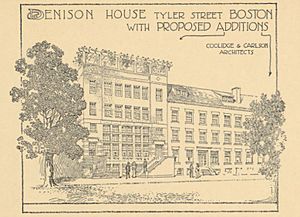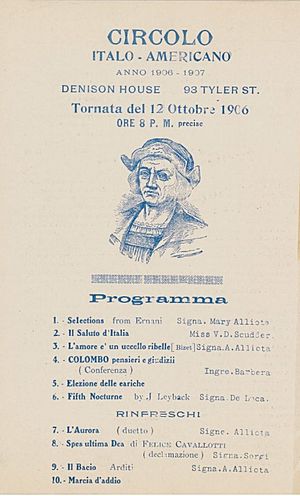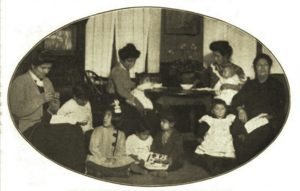Denison House (Boston) facts for kids
Denison House was a special place in Boston, Massachusetts. It was a "settlement house" run by women, which means it was a community center that helped people in need. It opened in 1892 in the old South Cove neighborhood.
Denison House offered many services, like classes and social activities. Most of the people it helped were immigrants who had recently moved to the area. Many famous women worked there, including Emily Greene Balch, who won a Nobel Prize, and Amelia Earhart, a brave pilot. Today, the original building at 93 Tyler Street is part of the Boston Women's Heritage Trail.
Contents
History of Denison House
How Denison House Started
Denison House began in 1892. It was one of the first branches of the College Settlements Association (CSA). This group was started by women from Wellesley College. They included Emily Greene Balch, Vida Scudder, and Katharine Lee Bates.
The house was named after Edward Denison, an English social reformer. He believed in living among people to help them. Denison House was inspired by Jane Addams's Hull House in Chicago. Its goal was to offer education and help to Boston's poor.
The women also wanted to bring different groups of people together. They hoped to break down barriers between rich and poor. They believed this would help democracy work better. They wanted "a free flowing life between group and group."
The first Denison House was at 93 Tyler Street. It was a red brick house. Soon, it needed more space. The house next door was added. By the 1920s, Denison House used five connected houses. Emily Greene Balch was the first leader, but she only stayed a short time.
Helping the Community (1893–1912)
Helena Dudley became the new leader in 1893. She led Denison House until 1912. When she arrived, times were tough, and many people needed help. Dudley quickly organized the house to give out basic things like milk and coal.
Under her leadership, Denison House became a very important place. It offered classes in many subjects. People could learn nursing, English, crafts, cooking, and carpentry. There were also sports and a summer camp for kids. Adults could join clubs. The house had a library, a gym, and a health clinic.
Helena Dudley also worked with other settlement houses. They held art shows and looked into housing problems. They also worked to get public bathhouses and gyms built.
People who came to Denison House were encouraged to share their cultures. Many were immigrants from different countries. They held cultural festivals and craft shows. One show in 1917 displayed beautiful items. These included silver, leather, and embroidered silks. They were made by Italian, Syrian, Greek, and Armenian artists. Many items were sold, and the show was a big success.
Teenage boys from the Denison House drama club performed plays by Shakespeare. They did this to raise money for the house. Their performances even got good reviews in the Boston Globe newspaper.
Supporting Workers' Rights
Mary Kenney O'Sullivan, a leader for workers' rights, lived at Denison House. She stayed there for several years in the 1890s. O'Sullivan, Helena Dudley, and Vida Scudder helped start the Women's Trade Union League in 1903. This group worked to improve conditions for women workers.
Mary Morton Kehew was another important woman involved. She helped manage the money for Denison House. Many workers' unions held their meetings at Denison House. In 1904, Catherine Breshkovsky, a famous Russian activist, visited for several weeks.
In 1912, Dudley and O'Sullivan helped two strike leaders. They paid bail for Joseph Ettor and Arturo Giovannitti. These leaders were arrested during the 1912 Lawrence textile strike. Vida Scudder also supported the strikers. She gave a speech that was widely talked about. Some wealthy people who donated to Denison House were worried about these connections to unions. It became harder to raise money. Because of this, both Dudley and Scudder had to leave their jobs.
Amelia Earhart's Time (1912–1942)
Before she became a world-famous pilot, Amelia Earhart worked at Denison House. She started in 1926. By the fall of 1927, she worked full-time at 93 Tyler Street. She stayed there until her famous flight in the Friendship airplane in June 1928.
Amelia drove to work from Medford, Massachusetts in her bright yellow car. During the week, she taught classes and visited families. On weekends, she spent her time flying. By this time, more and more Chinese immigrants lived in the neighborhood.
Earhart was in charge of adult education. She also supervised programs for girls. She organized clubs for women, like the Syrian Mothers Club. She even coached girls' basketball and fencing. In 1927, she flew over Boston and Cambridge. She dropped leaflets from her plane to advertise a Denison House fundraiser.
The next year, she represented Denison House at a big meeting. Other leaders were very impressed with her. They thought she was "one of the most promising social workers of her generation."
Denison House Today
In 1942, Denison House moved to Dorchester. It used several buildings there. In 1949, it moved into the old Howard Avenue School. In 1965, Denison House joined with other community centers. They formed the Federated Dorchester Neighborhood Houses (FDNH). This group later became College Bound Dorchester in 2010.
The original Denison House location on Tyler Street is now apartment buildings. It is still a stop on the Chinatown/South Cove walk of the Boston Women's Heritage Trail.
Denison House's Impact
Denison House had a lasting impact on many people. Mary Kingsbury Simkhovitch, a city planner, visited Denison House. This experience greatly influenced her. In 1902, she started Greenwich House in New York City. This settlement house is still helping people today.
The famous poet Kahlil Gibran and his younger relative, the sculptor Kahlil Gibran, lived nearby as children. They often visited Denison House. It was there that the elder Gibran met Fred Holland Day. Day was an artist and publisher who encouraged Gibran's creative talents. The younger Gibran later remembered seeing Amelia Earhart there. He recalled her wearing riding pants and driving her bright yellow car.
See also




